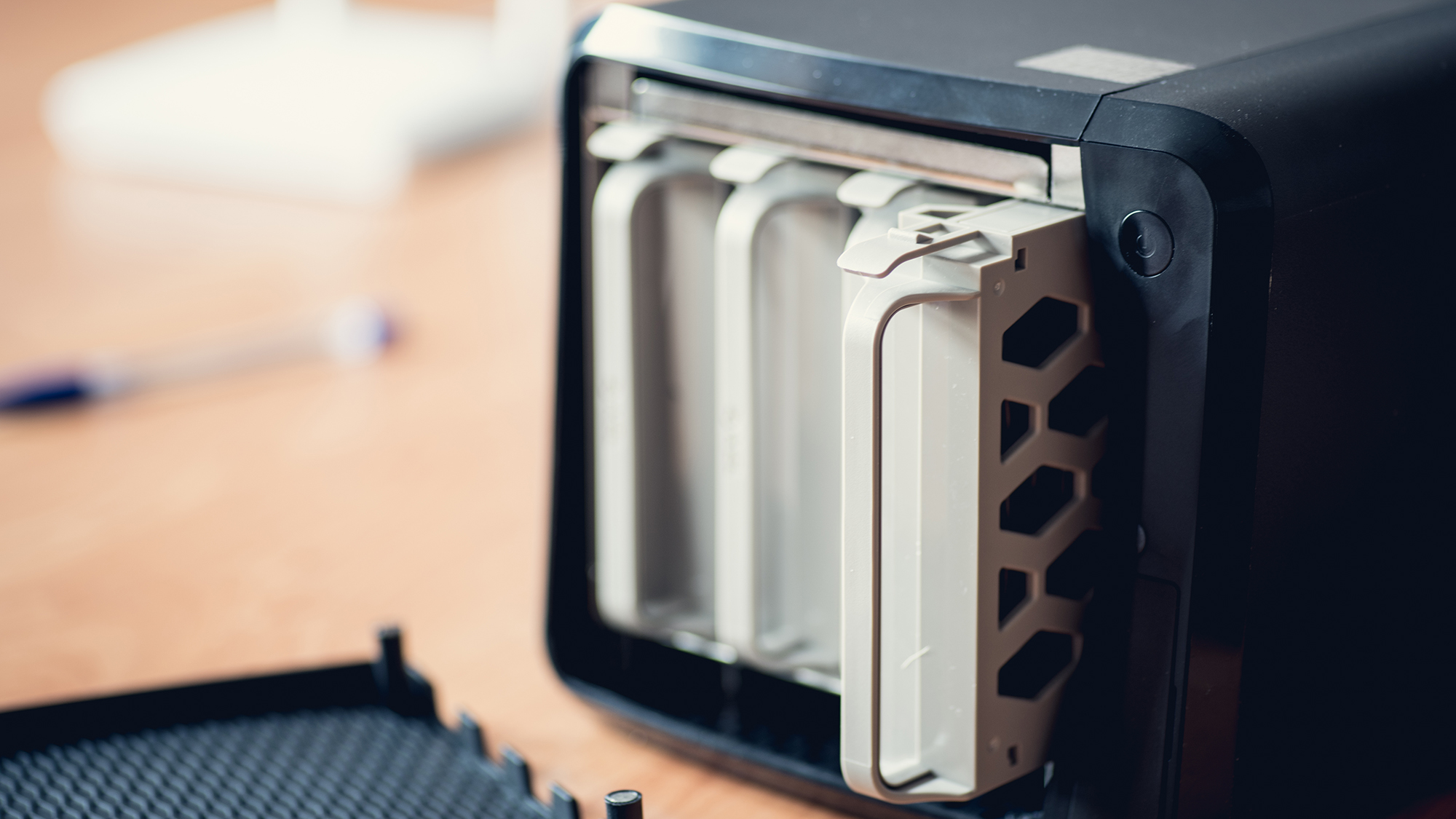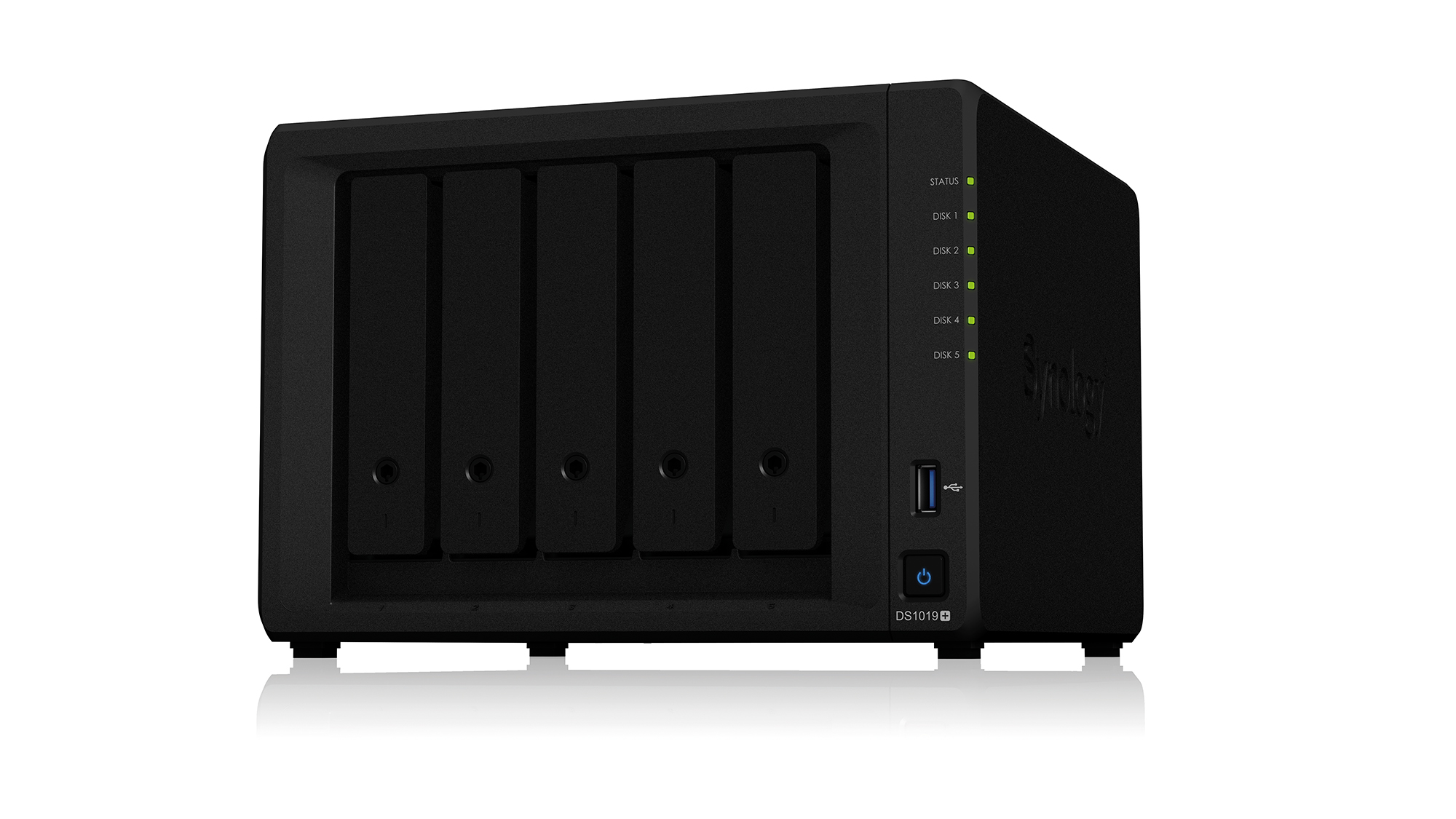Back up your files with these top NAS drives
A NAS is the one box every home and business should have. We put nine flexible devices through their paces to find a winner


You might think that four bays would be enough for all but the most ambitious enthusiasts and businesses, but a new breed of five-bay NAS drives has arrived to prove you wrong. Synology is early into the fray with its new DS1019+, giving all the storage goodness we would have previously seen in the award-winning DS-918+, but with capacity for an extra drive.
So why is a five-bay appliance better than a four-bay one? Capacity is the obvious answer, particularly if you use the more space-efficient RAID5 and RAID6 configurations or the company’s own Synology Hybrid RAID (SHR). What’s more, using five drives in a RAID6 or SHR setup gives you redundancy across two drives with the minimum of lost capacity; lose two drives and your NAS keeps on trucking with all your data still recoverable, without you wasting terabytes in the process.
Of course, you don’t have to fill the DS1019+ to capacity all at once. You can add the drives you require and then upgrade later. In fact, you’re positively encouraged to by the elegant, tool-less design, where the trays slide out and neatly clip back into place once filled, with the drives held in, without screws, by click-in side plates. An Allen key locks the drives securely in position, while the DS1019+’s chassis manages to feel simultaneously light and solid. And while the twin 92mm fans at the back threaten to make a racket, this isn’t a particularly loud NAS. In fact, at 20.8dB, it’s not noticeably noisier than most compact two-bay NAS devices.
You could argue that the DS1019+ doesn’t have all the connectivity of some Asustor and Qnap rivals, but then it’s not trying to be a media centre or a desktop PC, just a NAS with some server aspirations. To this end it has no HDMI video output or inputs for a keyboard and a mouse: there’s just a USB 3 port on the front and another at the rear, where you’ll also find an eSATA port. This allows you to expand the DS1019+ with a five-bay DX517 expansion unit, which then effectively transforms it into a ten-bay NAS.

The upgrade options don’t end there, either. In the base of the unit, you’ll find dual M.2 NVMe SSD slots, where you can fit one or two M.2 drives to use as a cache. The DS1019+ also has dual Gigabit Ethernet ports, giving you link aggregation – either for optimised performance or for resilience should one network connection go down.
Hardware has always been just one part of Synology’s success story, and while some of the other manufacturers are beginning to catch up with its DSM software, it’s still the most mature, feature-packed and carefully thought-out NAS operating system of the bunch. The setup process takes you through the key stages of adding drives, creating a storage pool and setting up your NAS, and from there you can go with Synology’s recommended apps or install your own manually later on. Basic processes such as managing users, creating shared folders and applying permissions are logical and easy to follow, and things that don’t always work reliably on other systems just seem to work.
What’s more, this is a hugely versatile NAS. It’s a great choice for more basic file-sharing and backup duties, or for providing iSCSI target storage for virtual machines. Yet it can also take on a range of cloud-like and server-like duties, including email, Dropbox-style synced folders, instant messaging and even project management and Office apps. With Hyper Backup it will back up crucial files to Dropbox, Google Drive, AWS or Microsoft Azure, while Synology’s own apps give you a wide range of media server tools, covering video, music and photo streaming, complete with artificial intelligence subject and face-recognition tools.
Get the ITPro daily newsletter
Sign up today and you will receive a free copy of our Future Focus 2025 report - the leading guidance on AI, cybersecurity and other IT challenges as per 700+ senior executives
All of this requires a certain level of performance, so it’s lucky that the DS1019+ is one of the fastest NAS servers we’ve seen. Its file transfer speeds in our backup tasks were within a whisker of the Asustor Nimbustor AS5304T and it’s in the leading pack when it comes to sequential read and write speeds, too. And where things get really tough, when copying files back and forth while streaming 4K video, the Synology is still neck-and-neck with the Asustor. Not everyone needs this kind of power or capacity, but if you do the DS1019+ is one of the best NASes you can buy.
Synology DS1019+ specifications
| Model number | DS1019+ |
| Price (inc VAT) | £514 (£642) |
| Warranty | 2yr RTB |
| Dimensions (WDH) | 223 x 230 x 166mm |
| Noise level | 20.8dB |
| CPU | Intel Celeron J3455 |
| CPU cores | Quad core |
| CPU speed, cores | 1.5GHz to 2.3GHz |
| RAM/maximum RAM | 8GB/8GB |
| Bays (free) | 5 (5) |
| Drive type | 3.5in hard disk/2.5in hard disk |
| Max internal capacity | 80TB |
| RAID modes | SHR, JBOD, 0, 1, 5, 6, 10 |
| Bay type | Slide-in caddy |
| Hot swap? | Yes |
| 2.5in drives supported | Yes |
| SSD support | 2.5in SATA, M.2 NVMe |
| Status display | 6 x status LEDs |
| Gigabit Ethernet ports | 2 |
| 10GB Ethernet ports | No |
| USB ports (rear) | USB 3 |
| USB ports (front) | USB 3 |
| Other | eSATA |
| 802.3ad link aggregation | Yes |
| Load balancing | Yes |
| Network failover | Yes |
| Major network protocols | SMB, NFS, FTP, SNMP, LDAP, CalDAV |
| iSCSI target | 128 |
| USB expansion options | Yes |
| NAS OS/firmware | Synology DiskStation Manager |
| Main desktop software | Synology DiskStation Manager |
| Remote access | Cloud Station Drive, Cloud Station Sharesync |
| Cloud integration | iDrive, Elephant Drive |
| Backup | Acronis TrueImage, Active Backup, Glacier Backup, Hyper Backup |
| Media | Audio Station, Video Station, Memories, iTunes Server, MinimServer, Plesk, Logitech Media Server, |
| Surveillance | Surveillance Station |
| Testing and Development | Docker, Java, Node.js, PHP, Perl, Python, Ruby, GitLab |
| Other major services | Drupal, Magento, MailPlus, Moodle, Synology Office, Virtual Machine Manager, Chat Server |
Stuart has been writing about technology for over 25 years, focusing on PC hardware, enterprise technology, education tech, cloud services and video games. Along the way he’s worked extensively with Windows, MacOS, Linux, Android and Chrome OS devices, and tested everything from laptops to laser printers, graphics cards to gaming headsets.
He’s then written about all this stuff – and more – for outlets, including PC Pro, IT Pro, Expert Reviews and The Sunday Times. He’s also written and edited books on Windows, video games and Scratch programming for younger coders. When he’s not fiddling with tech or playing games, you’ll find him working in the garden, walking, reading or watching films.
You can follow Stuart on Twitter at @SATAndrews.
-
 CISA issues warning in wake of Oracle cloud credentials leak
CISA issues warning in wake of Oracle cloud credentials leakNews The security agency has published guidance for enterprises at risk
By Ross Kelly
-
 Reports: White House mulling DeepSeek ban amid investigation
Reports: White House mulling DeepSeek ban amid investigationNews Nvidia is caught up in US-China AI battle, but Huang still visits DeepSeek in Beijing
By Nicole Kobie